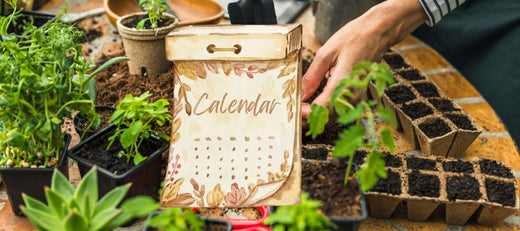Morning Glory is a beloved annual plant that gets its name from its colorful trumpet-shaped blooms that open in the cool hours of the morning. It is a quick-growing vining plant with lovely heart-shaped leaves that produces lots of blooms providing color from summer into early fall.
Let’s take a look at the history and benefits of this beautiful plant, and learn how you can grow morning glory flowers from seed.
The Rich History of the Morning Glory Flower
There are over 1000 species of Morning Glory. One of the most common is native to Central and South America and was introduced to Europe in the 1500s. This flower was highly revered by ancient Mayans, Aztecs, and Native American tribes of Mexico. Their seeds were used in spiritual rituals due to their psychoactive properties allowing users to feel they could communicate with their deities. In ancient China, the morning glory was used medicinally as a laxative. It symbolized love and affection, often associated with a folk legend of two lovers meeting once a year. In Japan, this flower has been cherished since the 700s as a symbol of fleeting beauty and is celebrated annually at the Iriya Morning Glory Festival in Tokyo. The Festival takes place in July with a large market selling all kinds of morning glories.
The popularity of the morning glory surged in the 19th century in Victorian England and the Americas. In the language of flowers, morning glories meant affection and unrequited love. It was also a popular motif in Victorian decor on furniture and textiles. Their quick-growing nature made morning glories a popular option for disguising less attractive structures like outhouses.
The Grandpa Ott Morning Glory (Ipomoea purpurea) variety that we offer here at Survival Garden Seeds has an interesting history. The seeds are a self-sowing, free-blooming Bavarian variety that were brought to the Americas by John Ott’s great-grandparents. John Ott, or ‘Grandpa Ott,’ meticulously preserved the seeds, passing them down to his granddaughter Diane Ott Whealy, who along with her husband Kent, founded the Seed Savers Exchange, making this and other heirloom seeds more widely available to gardeners.
Why Your Garden Needs Morning Glories

Morning glory flowers bring your garden benefits beyond beauty. Their stunning, trumpet-shaped blooms come in a vibrant array of colors and are nectar-rich, making them especially attractive to hummingbirds, bees, and butterflies to support your local ecosystem. They are remarkably simple to grow, even for beginning gardeners. Their quick growing vines and lush leaf cover make morning glories useful for covering fences, trellises, arbors, or acting as a privacy screen.
How to Grow Morning Glory Flowers
Choose the right location for your morning glories. They need 6 to 8 hours of full sun daily for abundant blooms. The soil should be fertile and well draining, but not too rich in organic matter. Too much nitrogen in the soil could lead to very leafy vines but few flowers. You will also want to have something for the vines to climb on, like a trellis, arbor, or fence.
Morning glories are typically grown from seeds. You likely will not find morning glory seedlings at your local greenhouse or garden center. They are relatively easy to grow, as long as you follow a couple of important steps.

First of all, you will need to prepare the seeds. Morning glory seeds have a thick, hard seed coat and will germinate better and faster if you scarify and soak the seeds in warm water overnight. To scarify the seeds, you can rub the seed coat with some sandpaper or a nail file to break the surface a little bit.
While you can start seeds indoors 4 to 6 weeks before your last frost date, morning glory seedling roots are delicate and must be handled carefully when transplanting. It is recommended to directly sow the seeds outdoors after the last frost date when the soil has warmed to 65-75°F to avoid damaging the roots. Space the seeds 6 to 12 inches apart. They should germinate in 1 to 3 weeks.
Morning Glory Plant Care and Maintenance
Once established, morning glories do not need a lot of fuss. You shouldn’t have to fertilize them. Water consistently, especially during dry spells, but avoid overwatering as this can lead to mildew or fungus. Some common pests are aphids and spider mites, which can be controlled by natural predators like lady bugs or a stiff blast with water from the hose. You’ll want to avoid using pesticides that might harm the pollinators these flowers attract. Deadheading blooms is optional, but it can help prevent excessive self-seeding.
Troubleshooting Tips
Some issues you may notice with your morning glory plants are:
- Lack of blooms - this may be caused by too much nitrogen in the soil, not enough sunlight, or poor drainage. A common solution for too much nitrogen is to use mulch like wood chips or saw dust around your plants. The mulch will absorb nitrogen as it breaks down.
- Yellowing leaves - this is a sign of overwatering or possible pests.
- Leggy growth - this is usually an indication of insufficient light.<
Controlling The Spread of Morning Glory Plants

Morning glory plants are known for their enthusiastic self-seeding. While this can be a benefit by providing continuous blooms, it can also lead to unwanted spread. If you want to enjoy this beautiful plant and keep it under control, there are several things you can do to manage the spread of morning glories.
- Deadheading - This is the most direct and effective method. Regularly remove spent flowers before they have the chance to form a seed pod. Once the petals fade, the plant starts to develop seeds, so timely intervention is important.
- Prompt fall cleanup - Since morning glories are an annual in most areas, they will die off with the first hard frost. Once the plants have died back, thoroughly remove the entire vine, including any seed pods. Don’t put them in your compost pile as the seeds can remain viable and sprout there. Bag them up and dispose of them properly.
- Mulching - A thick layer of organic mulch, like wood chips or bark, around your plants can suppress germination by blocking sunlight and creating a physical barrier. This is helpful where you want to prevent new seedlings from sprouting. In the fall, apply mulch to cover any possible dropped seeds, and again in the spring before new seedlings emerge.
- Hand-pulling seedlings - If, despite your best efforts, a few seeds manage to sprout, the seedlings are easy to pull and remove. Removing them before they mature and start to bloom will help control the spread.
- Strategic location planning - Consider planting morning glories in a location where the spread will not cause issues, or plant in containers to keep them in check.
Embrace the Joy of Morning Glory Flowers
From their rich history in ancient cultures to their vibrant blooms that attract pollinators, morning glories offer a multitude of benefits to any garden. With simple steps like scarifying seeds, providing ample sunlight, and offering a climbing structure, even beginner gardeners can enjoy these beautiful, easy-to-grow annuals. Don't miss out on the fleeting beauty and charm of morning glories in your own backyard. Get your morning glory seeds today and cultivate a glorious display!

























